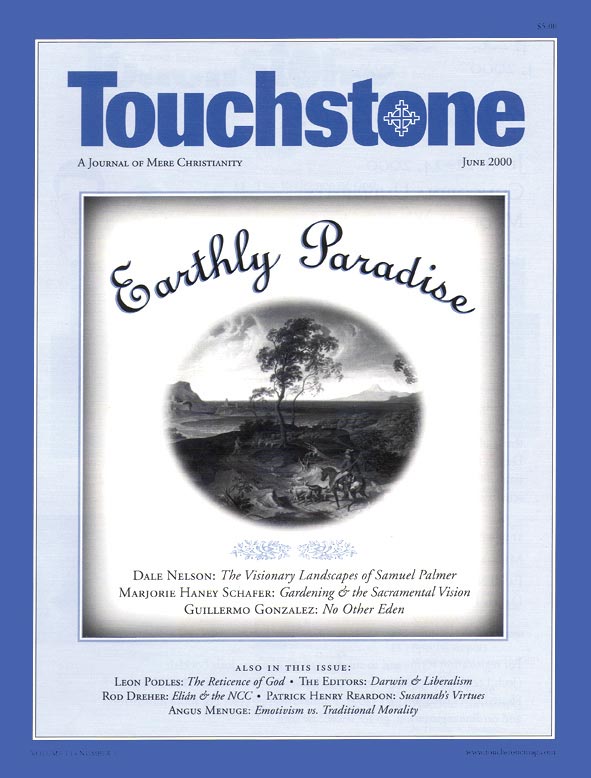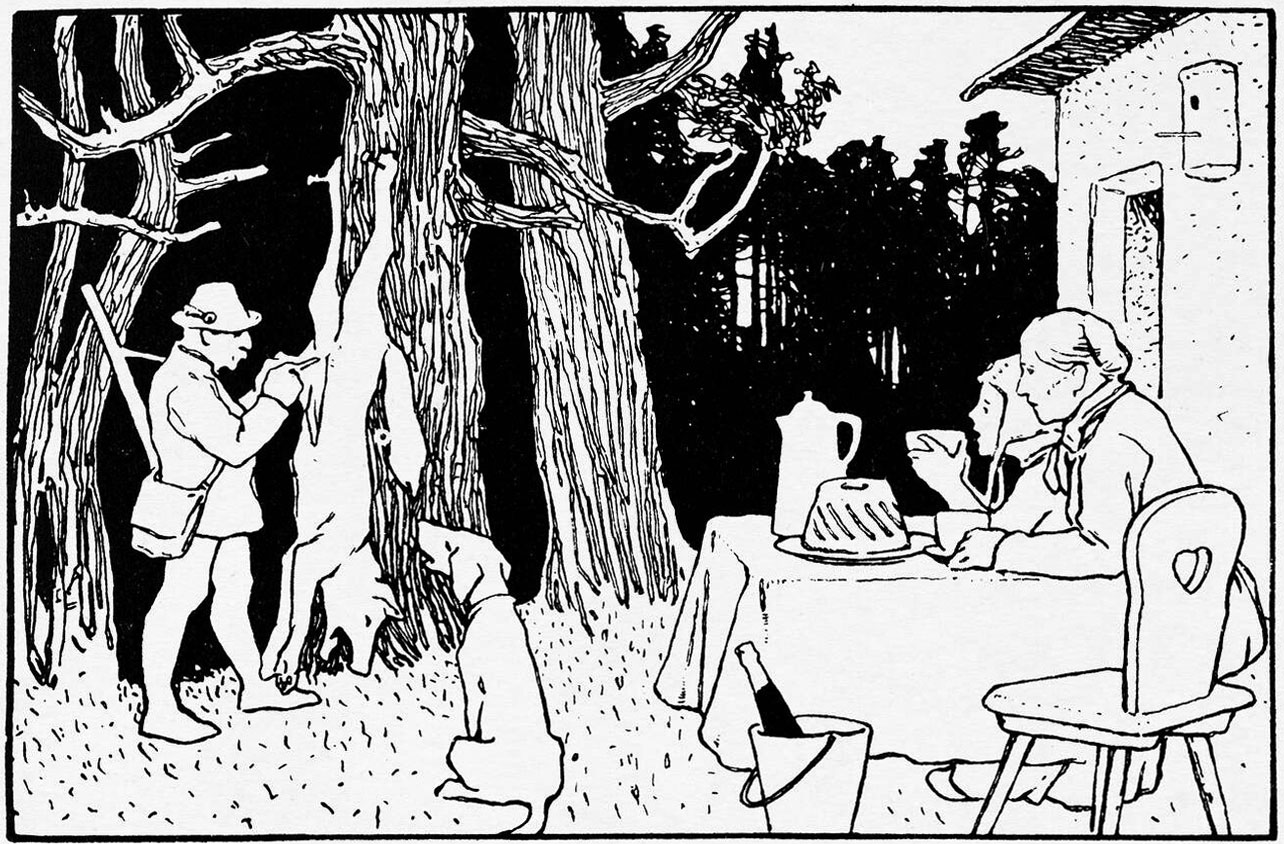The Corners of Paradise
Underriver: Samuel Palmer’s Golden Valley
by Griselda Barton and Michael Tong
Brasted Chart, Westerham, Kent: Froglets, 1995
(32 pages; £12.95, paper)
Samuel Palmer
(Ashmolean Handbooks series)
by Colin Harrison
Oxford: Ashmolean Museum, 1997
(80 pages; £10.95, cloth)
by Dale Nelson
“The days will come, in which vines shall grow, each having ten thousand twigs, and in each twig ten thousand shoots, and in each one of the shoots ten thousand clusters, and on every one of the clusters ten thousand grapes. . . . And when any one of the saints shall lay hold of a cluster, another shall cry out, ‘I am a better cluster, take me; bless the Lord through me.’ In like manner, the Lord declared that a grain of wheat would produce ten thousand ears, and that every ear should have ten thousand grains, and every grain would yield ten pounds of clear, pure, fine flour; and that all other fruit-bearing trees, and seeds and grass, would produce in similar proportions; and that all animals feeding only on the productions of the earth, should in those days become peaceful and harmonious among each other, and be in perfect subjection to man.”
If Samuel Palmer (1805–1881) had read these words during his youthful visionary years, he surely would have approved of them not as a millenarian prophecy (reported by St. Irenaeus), but as a torrent of words partaking of the “excess” he sought for his paintings and drawings. Those works specify no time, but do specify a place, Kent in southern England.
“The Magic Apple Tree,” an 1830 watercolor, presents a tidal wave of ripe golden wheat rushing towards a church steeple, in front of which is “an apple tree loaded to the extremity of every twig with bright crimson apples so numerous and enormous as far to surpass the utmost stretch of possibility.” Thus the “excess” appeared to Palmer’s son and biographer, who was also the eventual destroyer of an immense quantity of his father’s notes and sketches. A. H. Palmer wrote for audiences more accustomed, in their religious art, to conventionalized biblical scenes with well-scrubbed Galilean peasants than to such works of an “ill-controlled and powerful imagination.” The biographer was, likewise, uneasy about the sanity of William Blake, whose disciple Samuel Palmer was during the last three years of Blake’s life (1824–1827). Those years were the beginning of Palmer’s period of greatest achievement, when he was still a very young man.
Like Blake’s, Samuel Palmer’s achievement has been a “discovery” of our own century. Two recent books and two fine reproductions present some of Palmer’s most characteristic masterpieces. Some of these works by the young Palmer recall Brueghel or Blake, or even icons, and some of them are passionate and intense; others provide for us serene, assured visual analogues of J. R. R. Tolkien’s Shire.
Palmer, the son of an unambitious London bookseller, created fascinating designs even before he met Blake at the age of 19. Palmer’s 1824 sketchbook has been reproduced in facsimile by the William Blake Trust (1962). Recurrent images, even so early, are huge harvest moons or crescent moons, churches, trees, shepherds, tilled fields, studies of leaves, sheep, and oxen; in the midst of these drawings, a monk; a design of the creation of the heavenly lights; and a ghastly image: as a vast ichthymorphic hellmouth yawns to receive him and Satan falls from heaven, the unrepentant thief shrieks and wrenches his right hand free, the spike tumbling.
That is the only hellish image that Palmer ever made, that survives, anyway. For he launched upon the making of the most convincing series of paradisal images in English art. They are “paradisal,” not strictly pictures of Paradise, because the small human figures in them work, tending sheep, planting, harvesting. Sawn wood bespeaks hard exertion. Still, the atmosphere is that of Psalm 65:9–13: “Thou visitest the earth. . . . Thou crownest the year with thy goodness. . . . The little hills rejoice on every side. The pastures are clothed with flocks; the valleys also are covered with corn; they shout for joy, they also sing.”
As Raymond Lister says in his introduction to the Underriver booklet, in the paintings and drawings Palmer produced during his approximately seven years in Kent (1826–1834, especially the first four years or so), “A little cornfield in an English valley could be transformed into a vision of divine munificence, or paradisal illumination.” Palmer’s words about a series of small engravings by Blake apply better to these works of his own: “They are visions of little dells, and nooks, and corners of Paradise; models of the exquisitest pitch of intense poetry. . . . Intense depth, solemnity, and vivid brilliancy only coldly and partially describe them. There is in all such a mystic glimmer as penetrates and kindles the inmost soul, and gives complete and unreserved delight. . . . The drawing aside of the fleshly curtain, and the glimpse which all the most holy, studious saints and sages have enjoyed, of that rest that remaineth to the people of God.”
Self-devoted to this artistic enterprise, Palmer had the example of Blake, a man he revered in memory, many years later, as one whose aim was single, whose path was straightforward, whose wants were few—“so he was free, noble, and happy.” Like Blake seeing a multitude of angels praising God, when his corporeal eye beheld the sun, Palmer could see branches form a Gothic church window—“but sometimes trees are seen as men. I saw one, a princess walking stately and with a majestic train.” Palmer caught the revelatory moments: “Sometimes the rising moon seems to stand tiptoe on a green hill top to see if the day be going and if the time of her regency be come.”
Palmer was much more attuned to the close study of visible nature than Blake was, but they were kindred spirits. When Palmer first met Blake, the old man was confined to his bed, but was at work upon his great designs for Dante. “He said,” Palmer recorded, “he began with fear and trembling. I said ‘O! I have enough of fear and trembling.’ ‘Then,’ said he, ‘you’ll do.’” Sir Kenneth Clark, in Landscape into Art, says that Palmer, “as the disciple of Blake, saw first with the spiritual eye, and in so doing found every blade of grass and leaf and cloud was designed according to God’s pattern. It was,” he adds, “the vision of the Middle Ages,” yet without any “antiquarian flavour.”
Beginning his sojourn at Shoreham, Palmer would pray “for the Holy Ghost thro’ the day to inspire my art.” He read Scripture. He tended a deepening commitment to the “Melchisedekian priesthood” maintained in the Church of England, as opposed to the Baptist religion of his upbringing. He lived frugally, having received a legacy that enabled him to dedicate himself to his art. He was celibate. This regimen may suggest the work of an iconographer. “Genius,” he wrote, “is the unreserved devotion of the whole soul to the divine poetic arts, and through them to God; deems all else, even to our daily bread, only valuable as it helps us to unveil the heavenly face of Beauty.”
“Coming from Evening Church” actually recalls icons. Compare the stately procession of worshipers with the assemblies in icons, the compacted arrangement of all of the pictorial elements, the freedom with perspective, including the flattened overhanging mountains or hills that are not dimmed by the intervening atmosphere of this world. “We are not troubled with aerial perspective in the valley of vision,” he wrote. As with icons, the central idea is “God is with us.” Of course, the iconographer aims to represent the dogma of his church; Palmer sought to express, for himself and the few sympathetic others, his intuitions and his eager study of light, color, shade, and texture in a very beautiful part of England. Sometimes the work was joyous, and sometimes the young aspirant was miserable. In 1828 he wrote, “I will surrender to be shut up among the dead, or in the prison of the deep, [if] so I may sometimes bound upwards; pierce the clouds; and look over the doors of bliss.”
Oxford’s Ashmolean Museum has what must be the finest collection of Palmer’s works from this Shoreham period. To view such masterpieces as “The Magic Apple Tree,” “In a Shoreham Garden,” “Cornfield by Moonlight with the Evening Star,” and “A Hilly Scene,” one must visit elsewhere, but the Ashmolean contains “Pastoral with a Horse Chestnut Tree,” “The White Cloud,” and the definitive suite of six early sepia drawings—“A Rustic Scene,” “The Valley with a Bright Cloud,” “Early Morning,” “Late Twilight,” “The Skirts of a Wood,” and “The Valley Thick with Corn.” As Colin Harrison explains in the fine little book of 40 superb reproductions of Ashmolean Palmers, “The technique of these [sepia] works is unique: Palmer has used a fine pen to draw in minute detail every element of the composition, and has mixed the dark brown ink with gum to give the thick outlines the relief found in some etchings and some woodcuts. The addition of varnish unifies the composition, and gives the drawings the appearance of carved ivories, which has increased with age.” Each of the six drawings is clearly reproduced in this book at half the size of the original. They recall Isaiah’s prophecy of restored Israel, of Beulah—“the land shall be married”—which was taken up by Bunyan: “Now I saw in my dream, that by this time the pilgrims were got over the enchanted ground, and entering into the country of Beulah, whose air was very sweet and pleasant; the way lying directly through it, they solaced themselves there for a season, [hearing] continually the singing of birds, and every day the flowers appear in the earth.”
During the Shoreham years, Palmer lived with or near his retired father. In the evening, there was “blessed green tea time”—time for Shakespeare, Milton, Coleridge’s medieval fantasy “Christabel,” and religious works. Geoffrey Grigson, to whose 1947 book this article is much indebted, identifies works such as Isaac Barrow’s Sermons on the Creed and John Flavel’s Husbandry Spiritualized, where one reads, “The world below is a glass to discover [reveal] the world above: seculum est speculum.” Artistic young friends came down to keep Palmer company. They were “the Ancients,” disdaining conventional genre art, and their motto was “Poetry and Sentiment,” that is, imagination and warm, living feeling. Palmer wore utilitarian but unusual clothing and had fun with these friends. Once he teased an unduly solemn Edward Calvert by relentlessly singing “The British Grenadiers” (which Calvert disliked) to him. Some very lovely miniature engravings by Calvert from around this time survive, such as “The Chamber Idyll,” “The Bride,” “The Cyder Feast,” and “The Ploughman.” Another “Ancient,” George Richmond, eventually became a fashionable Victorian portraitist; but it was he who closed the eyes of Blake in death, and some 54 years later attended Palmer on his deathbed. We are indebted to Richmond and his descendants for their preservation of much of Palmer’s work.
As a hardworking artist, Palmer’s program included meticulous studies from nature (he also drew a searching self-portrait, included in the Ashmolean book), for example, of huge old “monumental” oaks with rifted, mossy barks and smooth beech pillars in Lullingstone Park, and yearning depictions of the effects of sunlight or moonlight on leaves and fields. He loved to draw and paint ancient cottages and farms, too. They, and a growing concentration on immense clouds, are characteristic of the work of the last two or three Shoreham years, from about 1830 on.
Underriver: Samuel Palmer’s Golden Valley reproduces works from the final Shoreham years. They have a Tolkienian, rather than iconic or Blakean quality; I would invite any interested person to take up Underriver and some of the pictures and prose passages presenting Tolkien’s Shire, where Bilbo Baggins lived at Underhill, Hobbiton, or Tolkien’s picture “Gate of the Elvenking’s Halls” in J. R. R. Tolkien: Artist and Illustrator. “The Weald of Kent” in Underriver hardly needs a hobbit or grey-cloaked Gandalf on the left or right edge to make it “Tolkienian.” Some of the Kentish place names—Pig and Whistle Valley, Rooks Hill—and even the style of the informal map in Underriver call to mind Tolkien’s conceptions. Colin Wilson, in Tree by Tolkien, says, “Tolkien is definitely a creator of scenery. This is all so strongly realized that one feels he ought to collaborate with an illustrator of genius.” I’d nominate a couple of the paintings in Underriver (and “View of Shoreham” in the Ashmolean book) for a special illustrated edition of Tolkien; they are more likely to succeed in enhancing Tolkien’s descriptions of the bucolic peacefulness of the Shire than the efforts of modern artists who have grown up in an environment of shopping malls and asphalt. (Even the recent Tolkien illustrations by Pauline Baynes are unsatisfactory; they are too pretty.) The authors of Underriver assure us that much that Palmer saw may still be seen. Their book should be of great usefulness to any Palmer admirer able to visit the area.
In 1837, at age 32, Palmer married Hannah Linnell, age 19, the daughter of the man who introduced him to Blake. They honeymooned in Italy for two years. Two of their three children died young. It’s the received wisdom that Palmer’s landscapes from this time on, which brought him much more recognition in his lifetime than the visionary drawings and paintings, are accomplished but conventional. He probably thought so. If he did not retain the power of his youth, he did retain his Anglican loyalties, despite the attacks of his domineering father-in-law. His most notable works, for the nearly fifty years after the Kentish period, are probably some very fine etchings on Virgilian and Miltonic themes, such as “The Lonely Tower” and “The Bellman,” which are included in the Ashmolean book. When artist Graham Sutherland saw one of Palmer’s etchings in the 1920s, he was, he wrote, “amazed at its completeness, both emotional and technical. It was unheard of at the [art] school to cover the plate almost completely with work, and quite new to us that the complex variety of the multiplicity of lines could form a tone of such luminosity.”
The youthful masterpieces remain to us as testaments to spirituality and English Romanticism. They are outstanding examples of one type of Christian art, that which emphasizes the goodness of God’s earth and its manifestation of his invisible attributes and the joys he has in store for his saints. This art is paradisal, free of conflict. Of course, another type of Christian art, e.g., many of Eric Gill’s pictures, may emphasize the conflict between holiness and sin, and, with conflict, may even become humorous. That is not Palmer’s vision.
I have invoked Blake, Brueghel, and icons, but really there is much in Palmer’s Shoreham oeuvre that is not redolent of prior art, but rather something new and indispensable. Two of Palmer’s Kentish paintings are available as excellent reproductions from the Tate Gallery, and it is to be hoped that others will be made available, not only by the Tate, but also by the Ashmolean, the Fitzwilliam, the Victoria and Albert, and others. Somewhat like icons in the “beautiful corner” of a Russian house, they might help to nurture a wholesome sensibility in parents and children who live with them.
Available Reproductions from the Tate Gallery, London “Coming from Evening Church” “The Gleaning Field” Suggested Additional ReadingGrigson, Geoffrey. Samuel Palmer: The Visionary Years. London: Kegan Paul, 1947. Also Samuel Palmer’s Valley of Vision (London: Phoenix, 1960). The first book is the one great classic on Palmer, with generous selections from his passionate letters. It recreates the years of Palmer’s supreme artistic achievement. The second book is an anthology of excerpts from Palmer’s surviving early memoranda and letters, with an introductory essay. Both books contain many monochrome plates. Today, though, critics sometimes dissent from what they regard as Grigson’s dismissal of Palmer’s later work. Cecil, David. Visionary and Dreamer. Princeton University Press, 1969. Palmer is the visionary, Edward Burne-Jones, the Pre-Raphaelite, is the dreamer. The plentiful reproductions are good, and the accompanying essay is well regarded. After consulting these, the admirer of Palmer may want to read Raymond Lister’s biography of Palmer, browse his two-volume edition of Palmer’s letters, or read A. H. Palmer’s indispensable, if sometimes wrongheaded, biography of his father. James Sellars’s Samuel Palmer reproduces many pictures, but the text is not recommended. |
Dale Nelson is an associate professor of English at Mayville State University in Mayville, North Dakota.
subscription options
Order
Print/Online Subscription

Get six issues (one year) of Touchstone PLUS full online access including pdf downloads for only $39.95. That's only $3.34 per month!
Order
Online Only
Subscription

Get a one-year full-access subscription to the Touchstone online archives for only $19.95. That's only $1.66 per month!
bulk subscriptions
Order Touchstone subscriptions in bulk and save $10 per sub! Each subscription includes 6 issues of Touchstone plus full online access to touchstonemag.com—including archives, videos, and pdf downloads of recent issues for only $29.95 each! Great for churches or study groups.
Transactions will be processed on a secure server.
more from the online archives
calling all readers
Please Donate
"There are magazines worth reading but few worth saving . . . Touchstone is just such a magazine."
—Alice von Hildebrand
"Here we do not concede one square millimeter of territory to falsehood, folly, contemporary sentimentality, or fashion. We speak the truth, and let God be our judge. . . . Touchstone is the one committedly Christian conservative journal."
—Anthony Esolen, Touchstone senior editor









